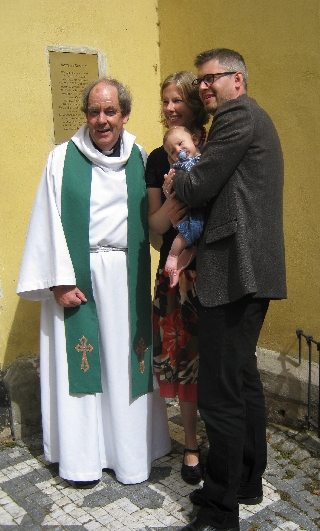
One of the privileges of being a Christian Minister is being part of what sociologists call people’s ‘major life events’ when I conduct baptisms, weddings or funerals. And because of the somewhat unusual nature of the Prague Anglican congregation, I have conducted relatively few of each of these over the past almost four years I have been here. This in turn has meant that I have been able to give each of these ‘occasional offices’, (as they are collectively known), more attention to detail than might normally otherwise be possible.
All but two of the weddings that I have conducted since arriving in Prague have been cross-cultural – between an English-speaker and a Czech/Slovak/Belarusian. These have inevitably raised cultural and linguistic issues about which I have written previously in this blog. But they have also, without exception, been most enjoyable occasions as relatives and friends of each happy couple, despite their different nationalities and languages, have joined together to celebrate.
Two years ago tomorrow, I conducted the marriage of Jan, a Czech, to Allison, an American. Late last year, I was thrilled to hear that they had taken notice of the third reason that marriage is given according to the preface to the Anglican Marriage Service, ‘as the foundation of family life in which children may be born and nurtured in accordance with God’s will, to his praise and glory’ – Allison was pregnant!
Little Martin Morris Rovný duly arrived in the world early in March of this year. In this era of social media, he had already appeared on Facebook even before he was born with his mother posting pictures of ‘her scan’. Since then, numerous photographs of him have also been posted online by his proud parents.
Jan and Allison currently live in Sweden, where Jan is a research fellow at the University of Gothenburg and Allison has successfully completed and defended her own thesis, as well becoming a mother to her young son. As they were intending to spend a good part of August in Prague with Jan’s family, they asked whether it would be possible for Martin to be baptised at St. Clement’s as in their current rather peripatetic existence, they do see it as their spiritual home. Therefore on Sunday 26th August during our Sunday Eucharist, I baptised Martin Morris in the name of the Father, the Son and the Holy Spirit, using the font that stands just a couple of metres from where his parents had stood almost two years previously to make their marital vows to each other.
As our opening hymn, we sang ‘Come, thou fount of every blessing’ to the American folk tune Nettleton. This was the hymn that Allison’s family, together with the bride and bridegroom, had sung to the rest of the congregation at their wedding – a cappello in four-part harmony! It is a hymn virtually unknown this side of the Atlantic although it does now appear in ‘Common Praise‘, the successor to ‘Hymns Ancient & Modern‘, published in 2000. Not being in the hymnbook we use, I had to reproduce the words on our ‘Weekly Bulletin’ – fortunately they are out of copyright! In doing so, we also made Larry from Texas happy, who was playing the organ for us that Sunday, by for once singing a hymn he knew to what he deemed to be the ‘correct tune’ 🙂
Whilst we had a large number of Jan’s Czech relatives present for the service, the only members of Allison’s family able to be present were her parents, Morris and Mary Elizabeth who had flown over from the USA, especially for the occasion. However, I was very pleased that Morris accepted my invitation to lead our intercessions, immediately following the baptism of his grandson, just as he had led the intercessions at his daughter’s wedding some two years before. It did make once again, for a very special occasion.
You can now listen to the whole service on our Church website
































